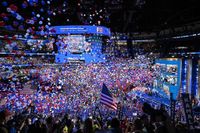California Governor Gavin Newsom has emerged as the frontrunner in the race for the 2028 Democratic presidential nomination, according to a series of recent polls conducted by Emerson College Polling. The August 25-26, 2025 national survey, which polled 1,000 active registered voters and 387 Democratic primary voters, revealed that Newsom’s support among Democrats has skyrocketed, more than doubling since June 2025. The poll, which carries a margin of error of ±3 percentage points for the national sample and ±4.9 points for Democratic primary voters, placed Newsom at 25%—a significant leap from his previous 12%.
"Governor Newsom’s support surged across key demographic groups, highlighted by a 12-point increase among voters under 30 (6% to 18%), an 18-point increase among voters over 70 (13% to 31%), and a 14-point increase among both Black (9% to 23%) and White (10% to 24%) voters," Spencer Kimball, executive director of Emerson College Polling, noted in the survey’s analysis, as reported by multiple outlets including Nexstar Media and Politico. This dramatic uptick has positioned Newsom ahead of other Democratic hopefuls, including former Transportation Secretary Pete Buttigieg, who maintained 16% support, and former Vice President Kamala Harris, whose support slipped from 13% in June to 11% in August.
The poll results underscore a shifting landscape in Democratic politics. While Newsom surged, Buttigieg’s support remained steady overall but saw notable declines among Latino voters (from 10% to 2%), Asian voters (from 12% to 0%), and younger voters aged 18-29 (from 7% to 3%). His numbers did tick up among voters aged 30-39 (from 9% to 16%) and those aged 60-69 (from 17% to 24%). Harris, meanwhile, experienced a mixed bag: her standing rose among Black voters (from 30% to 44%) and Hispanic voters (from 11% to 25%), but fell among White voters (from 7% to 4%) and Asian voters (from 12% to 0%). Harris also saw her support among voters aged 18-29 jump from 19% to 39%, but she lost ground in most older age groups.
Other Democratic contenders trailed significantly behind. Pennsylvania Governor Josh Shapiro garnered 5% support, while Illinois Governor JB Pritzker and Rep. Alexandria Ocasio-Cortez each received 4%. Michigan Governor Gretchen Whitmer, Senator Bernie Sanders, Senator Cory Booker, and several others registered below 3% each. Notably, about 3% of respondents indicated a preference for someone else, and 16% remained undecided, highlighting the fluidity of the field even as Newsom pulls ahead.
Despite his surge, Newsom’s 25% does not constitute a majority, and the pollsters point out that no Democratic candidate has yet captured at least half of the primary electorate—an expected scenario with three years remaining before the primaries. Still, Newsom’s rapid ascent is turning heads, especially given his growing national profile and willingness to engage directly with Republican leaders and President Donald Trump.
Newsom’s rise comes at a time of heightened political tension over congressional redistricting. Texas Republicans, under the guidance of the Trump White House, recently passed a new House map expected to help the GOP net five additional seats in Congress. Texas Governor Greg Abbott is expected to sign the map into law. In response, Newsom and California Democrats have introduced their own congressional map designed to offset Republican gains. This proposal will be put to California voters in a special election slated for November 4, 2025. According to The New York Times, if approved, the new districts could help Democrats flip as many as five seats—potentially neutralizing the GOP’s advantage from the Texas changes.
Partisan attitudes toward redistricting are sharply divided. The Emerson poll found that 56% of voters opposed California’s congressional redistricting plan, while 44% supported it. In Texas, 54% opposed the plan, and 46% supported it. However, the underlying partisan splits are stark: 77% of Texas Republicans back their state’s redistricting, compared to just 44% of California Republicans. Meanwhile, 52% of California Democrats support their state’s plan, but only 21% of Texas Democrats support the Texas plan. As Kimball explained, "Support for redistricting looks similar overall for Texas and California, but the partisan swings tell a different story."
Newsom has not shied away from the national stage, frequently using social media to mock President Trump. Throughout August, his press office mimicked Trump’s signature style, posting messages in all capital letters and launching a line of merchandise parodying Trump’s famous MAGA hats. One item, a red hat emblazoned with "Newsom was right about everything," directly riffs on Trump’s own slogan. These tactics have helped Newsom build a reputation as a leading Democratic foil to Trump and the broader Republican Party.
The 2028 general election is already shaping up to be highly competitive. In a hypothetical matchup between Newsom and Vice President JD Vance, the Emerson poll found the two candidates deadlocked at 44% each, with 12% of voters undecided. This represents a shift from July 2025, when Vance led Newsom 45% to 42%. Newsom’s gains are driven largely by younger voters aged 18-29, among whom he now leads Vance 45% to 28%—a notable swing from the previous month when the two candidates were virtually tied among this demographic.
On the Republican side, Vice President JD Vance appears to have consolidated his base, commanding 52% support in the GOP primary, far ahead of Secretary of State Marco Rubio (9%) and Florida Governor Ron DeSantis (7%). The poll also found that the economy remains the top issue for voters (33%), followed by threats to democracy (24%), immigration (12%), and healthcare (9%).
Beyond the presidential contest, the Emerson poll offered insights into other hot-button issues. Forty-one percent of voters said their family’s finances were worse off than a year ago, a four-point increase from July, while 28% said they were better off—a four-point decrease. The poll also revealed robust support for national marijuana legalization, with 65% of voters in favor, up five points since October 2024. Support was strongest among voters under 30 (71%) and those in their 40s (74%), while voters over 70 opposed legalization by a narrow margin (52% to 48%).
The survey’s methodology included a mix of email, text, and online panel interviews, with data weighted by gender, education, race, age, party registration, and region. As always, pollsters caution that results for demographic subsets carry higher margins of error due to smaller sample sizes, and that all polling should be understood as a snapshot in time rather than a prediction.
As the 2028 campaign cycle begins to take shape, Newsom’s surge in support and his willingness to take on Trump directly have cemented his status as a leading figure in the Democratic Party. With redistricting battles, shifting demographics, and a deeply divided electorate, the road to the White House promises to be anything but predictable.





